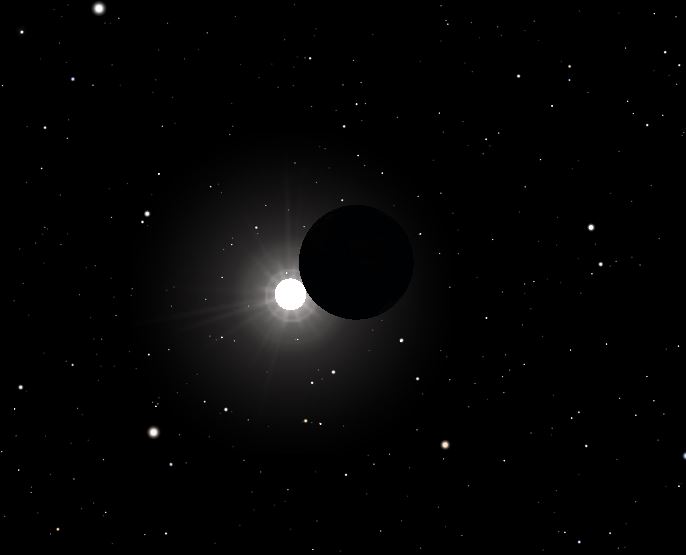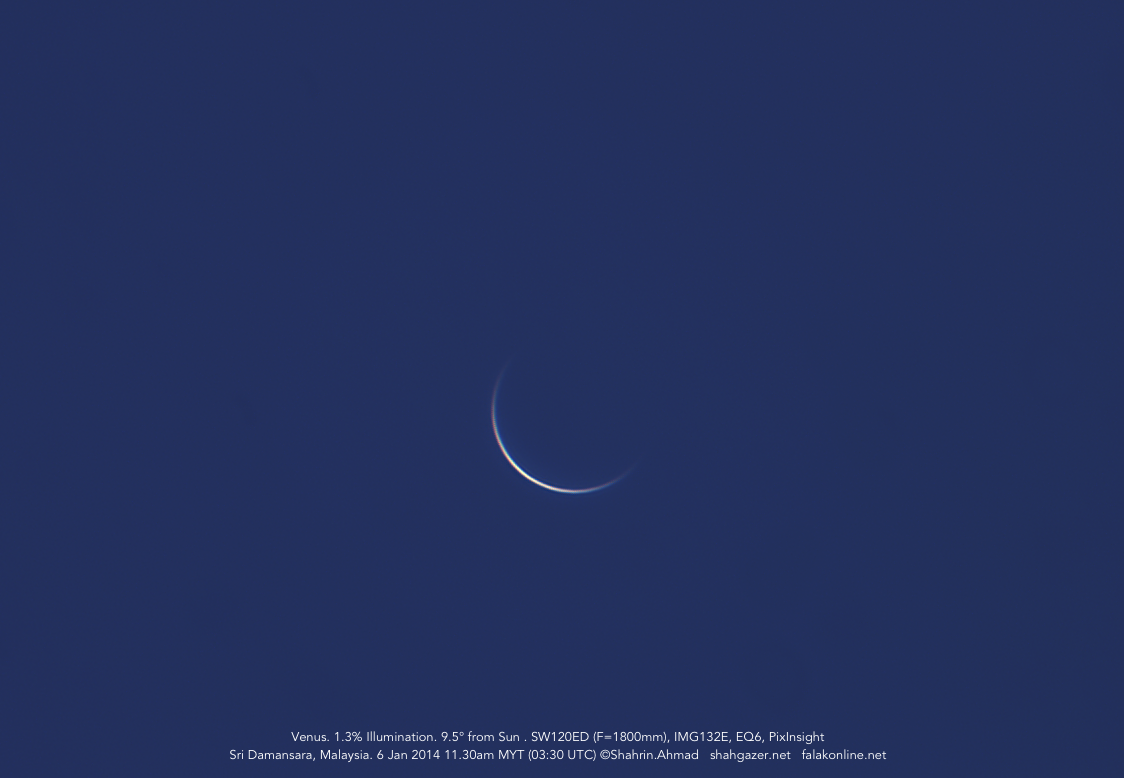Note that the ring in the solar telescope images is visible, but unresolved.alter-ego wrote:I don't believe a ring could be visible in today's APOD. If it exists it would be exceedingly thin and faint. In the first image on the left, Venus had ~2.2° elongation and a ring was barely visible around the full perimeter. Venus' elongation in today's APOD ~14°. Given the rapid increase in ring brightness over small elongation angles, I would say no ring should be visible (even from the Dunn Solar Telescope).
APOD: Clouds and Crescents (2014 Jan 04)
- Chris Peterson
- Abominable Snowman
- Posts: 18184
- Joined: Wed Jan 31, 2007 11:13 pm
- Location: Guffey, Colorado, USA
- Contact:
Re: APOD: Clouds and Crescents (2014 Jan 04)
Chris
*****************************************
Chris L Peterson
Cloudbait Observatory
https://www.cloudbait.com
*****************************************
Chris L Peterson
Cloudbait Observatory
https://www.cloudbait.com
- alter-ego
- Serendipitous Sleuthhound
- Posts: 1120
- Joined: Mon Apr 21, 2008 4:51 am
- Location: Redmond, WA
Re: APOD: Clouds and Crescents (2014 Jan 04)
Yes. My last statement maybe is a bit confusing. I meant that the DST likely couldn't have seen a Venus ring on Jan 2.Chris Peterson wrote:Note that the ring in the solar telescope images is visible, but unresolved.alter-ego wrote:I don't believe a ring could be visible in today's APOD. If it exists it would be exceedingly thin and faint. In the first image on the left, Venus had ~2.2° elongation and a ring was barely visible around the full perimeter. Venus' elongation in today's APOD ~14°. Given the rapid increase in ring brightness over small elongation angles, I would say no ring should be visible (even from the Dunn Solar Telescope).
Despite the apparently high DST resolution, the Hinode picture (2012 transit) shows a more true perspective of the thin ring (though still maybe not fully resolved)
A pessimist is nothing more than an experienced optimist
- geckzilla
- Ocular Digitator
- Posts: 9180
- Joined: Wed Sep 12, 2007 12:42 pm
- Location: Modesto, CA
- Contact:
Re: APOD: Clouds and Crescents (2014 Jan 04)
Well, one thing is for sure: We can never have too many pictures of our neighborly orbs being illuminated from behind. It dawns on me now that we do not have very many pictures of Earth occulting the Sun unless you count the myriad of sunsets and sunrises we see every day.
Just call me "geck" because "zilla" is like a last name.
Re: APOD: Clouds and Crescents (2014 Jan 04)
The ISS and other orbiting craft have produced some great shots of sunrises and sunsets, showing beautifully the full thickness (or rather, the thin fragility) of Earth's atmosphere.
- alter-ego
- Serendipitous Sleuthhound
- Posts: 1120
- Joined: Mon Apr 21, 2008 4:51 am
- Location: Redmond, WA
Re: APOD: Clouds and Crescents (2014 Jan 04)
Yeah, I think the Kaguya view a "solar eclipse" from the moon (2009) is the best one:geckzilla wrote:Well, one thing is for sure: We can never have too many pictures of our neighborly orbs being illuminated from behind. It dawns on me now that we do not have very many pictures of Earth occulting the Sun unless you count the myriad of sunsets and sunrises we see every day.
NASA - Science News (See movie)
A pessimist is nothing more than an experienced optimist
- geckzilla
- Ocular Digitator
- Posts: 9180
- Joined: Wed Sep 12, 2007 12:42 pm
- Location: Modesto, CA
- Contact:
Re: APOD: Clouds and Crescents (2014 Jan 04)
Nitpicker: Yeah, of course. That's still pretty close, though. Close enough that you can't get a photo like the one at the bottom of this page: http://donaldedavis.com/2003NEW/NEWSTUFF/DDEARTH.html ...or, also, what alter-ego posted while I was writing this response. Interesting video.
Just call me "geck" because "zilla" is like a last name.
Re: APOD: Clouds and Crescents (2014 Jan 04)
Fairy nuff. I thought the plan was to get the best backlit photo of the atmosphere, rather than the whole planet.
I hope Chang'e 3 is up to the task on the 15th of April:

Earth occults Sun in Psc, 20140415 0517 UT
From: http://asterisk.apod.com/viewtopic.php? ... 41#p216341
I hope Chang'e 3 is up to the task on the 15th of April:
Earth occults Sun in Psc, 20140415 0517 UT
From: http://asterisk.apod.com/viewtopic.php? ... 41#p216341
- geckzilla
- Ocular Digitator
- Posts: 9180
- Joined: Wed Sep 12, 2007 12:42 pm
- Location: Modesto, CA
- Contact:
Re: APOD: Clouds and Crescents (2014 Jan 04)
Admittedly, the difference between an eclipse and a sunset is hard to define. At what distance from Earth does a sunset become an eclipse? I feel like I've missed out on a lot of really obnoxious astronomy jokes by not realizing sooner that they are the same thing.
Just call me "geck" because "zilla" is like a last name.
Re: APOD: Clouds and Crescents (2014 Jan 04)
It's all syzygy:
https://en.wikipedia.org/wiki/Syzygy_%28astronomy%29
"Eclipse" is a more general term, covering both full occultations and partial disappearances from view, due to another real object, or its shadow.
https://en.wikipedia.org/wiki/Syzygy_%28astronomy%29
"Eclipse" is a more general term, covering both full occultations and partial disappearances from view, due to another real object, or its shadow.
- neufer
- Vacationer at Tralfamadore
- Posts: 18805
- Joined: Mon Jan 21, 2008 1:57 pm
- Location: Alexandria, Virginia
It's a syzygy!
Click to play embedded YouTube video.
Nitpicker wrote:
It's all syzygy:
http://en.wikipedia.org/wiki/Syzygy_%28astronomy%29
"Eclipse" is a more general term, covering both full occultations and partial disappearances from view, due to another real object, or its shadow.
Art Neuendorffer
- Anthony Barreiro
- Turtles all the way down
- Posts: 793
- Joined: Wed May 11, 2011 7:09 pm
- Location: San Francisco, California, Turtle Island
Re: APOD: Clouds and Crescents (2014 Jan 04)
Thanks Chris. When you say "refracted or scattered", what's the difference between refraction and scattering?Chris Peterson wrote:I don't see it in this image. But refracted or scattered, the edge of Venus is still optically unresolvable as anything other than solid from any small ground-based telescope (and likewise for the gas giants). The optical depth of the atmosphere is very high at visible wavelengths, resulting in a transition zone of no more than a few hundredths of an arcsecond even when Venus is near inferior conjunction.Anthony Barreiro wrote:Look at the edge of the dark side of Venus. There is slight refraction of sunlight through Venus' atmosphere.
When I look at the full resolution version of this image I see a very faint band of light extending almost all the way around Venus' dark limb. The very points of the illuminated crescent also look slightly fuzzy, rather than as sharply defined as the rest of the crescent. What could cause these effects other than sunlight shining through Venus' atmosphere?
May all beings be happy, peaceful, and free.
- alter-ego
- Serendipitous Sleuthhound
- Posts: 1120
- Joined: Mon Apr 21, 2008 4:51 am
- Location: Redmond, WA
Re: APOD: Clouds and Crescents (2014 Jan 04)
Anthony, although I see a suggestion of a tenuous limb outline, I believe it is an artifact of our brain completing the circle and/or artifacts of the image. To me, the edge is ill-defined and comes and goes depending how I look at it (zoom changes included). One obvious background non-uniformity is a broad halo to the right of Venus.Anthony Barreiro wrote: ...
When I look at the full resolution version of this image I see a very faint band of light extending almost all the way around Venus' dark limb. The very points of the illuminated crescent also look slightly fuzzy, rather than as sharply defined as the rest of the crescent. What could cause these effects other than sunlight shining through Venus' atmosphere?
Below is a better comparative image. It has a similar blue sky but sharper image and much better background uniformity. Also Venus has a 9.5° elongation here compared to the larger 14+° elongation in the APOD. I'd expect better dark-side limb visibility for the image below:
Universe Today It is interesting that I can convince myself that I see a similar circular edge here too, but viewing an enhanced contrast, BW negative of the image, the apparent circular ring goes away:
Below is a similar enhancement of the higher resolution image from your link:
Bottom line is, I think the edge you are seeing is a manifestation of our brain and image background non-uniformity.
A pessimist is nothing more than an experienced optimist
- Chris Peterson
- Abominable Snowman
- Posts: 18184
- Joined: Wed Jan 31, 2007 11:13 pm
- Location: Guffey, Colorado, USA
- Contact:
Re: APOD: Clouds and Crescents (2014 Jan 04)
Refraction occurs when light is bent by passing through some medium where the speed of light is less than c. An atmosphere has a density gradient created by gravity, and the speed of light varies with that density. So light can bend as it passes through the atmosphere. That's why when we observe the Sun on the horizon, it is actually below it. Scatter is just light bouncing off of particles.Anthony Barreiro wrote:Thanks Chris. When you say "refracted or scattered", what's the difference between refraction and scattering?
I'm not convinced this isn't an optical illusion. But in any case, all of the fuzziness in that image is coming from the light being stirred up in the atmosphere (a refractive process) and from diffraction caused by the telescope aperture. Any fuzzy edge around Venus is on the order of a hundredth of an arcsecond in width, and this image is limited by optics and seeing to a resolution of a few arcseconds. To actually resolve the edge of Venus's atmosphere would take a very large telescope located in space (or a smaller telescope very close to the Venus).When I look at the full resolution version of this image I see a very faint band of light extending almost all the way around Venus' dark limb. The very points of the illuminated crescent also look slightly fuzzy, rather than as sharply defined as the rest of the crescent. What could cause these effects other than sunlight shining through Venus' atmosphere?
Chris
*****************************************
Chris L Peterson
Cloudbait Observatory
https://www.cloudbait.com
*****************************************
Chris L Peterson
Cloudbait Observatory
https://www.cloudbait.com
- Anthony Barreiro
- Turtles all the way down
- Posts: 793
- Joined: Wed May 11, 2011 7:09 pm
- Location: San Francisco, California, Turtle Island
Re: APOD: Clouds and Crescents (2014 Jan 04)
Thanks to Chris and whoever stands behind the alterego. Darn, another misconception succumbs to math and physics. I suppose next you're going to tell me there aren't any canals on Mars.
May all beings be happy, peaceful, and free.
